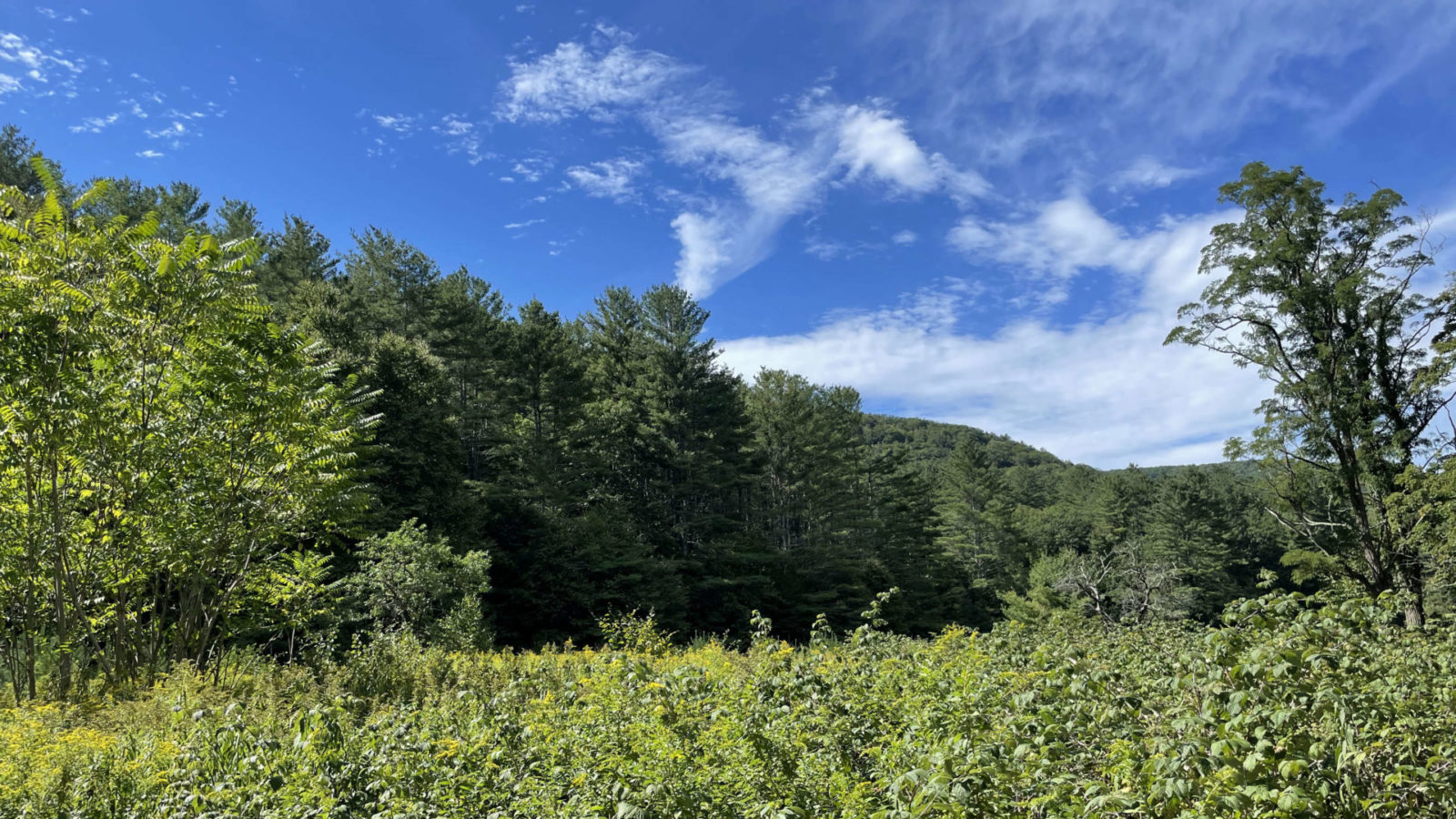In the sun, a warm huge being gives me a place to rest, and I’m leaning back against a giant’s ankle. Cousins stand around me 150 feet tall, and I’m sitting in a cup of roots. How many years has a white pine lived to grow broader than I can span even halfway?
The late afternoon light is falling into a gathering of trees, a few feet uphill from the river often now called the Deerfield. Berkshire naturalist Robert Leverett has rediscovered this holdout of old growth forest.

Old growth pine trees along the Deerfield River can stand 150 feet tall.
In state forest land in Charlemont, up on Route 2 just east of the county line, the Elder Grove trail has led me along the river to the tallest Eastern white pines in New England, nine feet around and more.
Earlier this summer, I read about Leverett’s work through Jonny Diamond’s story in the Smithsonian Magazine. Some of this story feels familiar, as a name heard over the years, and most is new to me. Sitting in the duff, trying to tip my head back far enough to see into the canopy, I’m asking how, in almost 25 years, I have never come here until today.
Bob Leverett’s name stirs memories from Tom Smith’s nature columns in the Eagle and conversations in my days in the newsroom of the old Berkshire Advocate. He was exploring the hills long before Lauren Stevens, the Advocate’s founder, and a group of Williams students led an effort to uncover or recover the trails here.
And though I’ve driven Route 2 through these river gorges for a generation, and hiked closer to North Adams, I’ve rarely gone hiking (or paddling or exploring) this far east. So I set out today to find the trail and the trees.
The way begins with a short stretch through pine woods on a slender path clay red with pine needles. (The markings are often clear, but I walk off the path early on when it forked and I took an older way that faded out a few hundred yards farther on.)
Over the hill and down, I come out onto a broader track along the river. The way opens into a high meadow dense with golden rod, and you can keep to the clearings in the sun or follow the river bank in the shade.
I walk down to the river bank in a small clear resting place and lie on my back in the grass, listening to the water. A small fleet of inflatable rafts drifts by, and I realize the launch for Zoar Outdoor’s expeditions must be close by across the river.
I’m following the trail named for the Mohican nation and the Kanienkehaka (Mohawk).
and looking for its meeting place with the trail to the Elder Grove. It moves through younger woods and then climbs gently upward. And then the Elder Grove trail moves on, above the water, into an older belt of woodland.
Leverett has found a rare stretch of forest that European incomers didn’t log out completely within 150 years of reaching here. When these white pine were saplings, around the Civil War, the farms and the paper mills, the sawmills and the charcoal burners were stripping the hills between them. Nineteenth-century photographs can show a stark bareness even high on the ridges.
But here, along the side of the gorge, with a steep ridge protecting them from the road,
trees 200 to 400 years old are still growing. I walked past them at first, following the trail all the way to its far end as it comes back to the river and the road. On the way back, taking care, I found the subtler suggestion of a path that lifts a few feet up the hill into a group of trees standing together.
They are massive and beautiful. I rest here in the roots, in a hollow softened with pine needles, leaning into the solid weight of the trunk and the nap of the bark. I find the scale of them hard to take in, rising into the sky. How do they see me, a two-footed creature moving slowly and clumsily over the forest floor …
Leverett has called them Trees of Peace, Diamond says, in honor of the Haudenosaunee, who hold the white pine as a symbol of peace. He names them in honor of Native leaders, some of them people he knows through his first wife, Jani A. Leverett, “who was Cherokee-Choctaw, and who died in 2003.”
Finally, slowly, I make my way to fellow trees in the circle, one by one, and then along the trail. I could follow the river all the way back, but when I come to the three-way split, I take the third way, continuing along the Mohican-Mohawk Trail to the summit.
The gorge rises steeply here, and this trail doesn’t believe in switchbacks. But it’s breathtaking in all senses. It hugs the slope, in places barely wide enough for two feet side by side. A tree has fallen recently enough to hold earth clinging in a wide fan of roots, and I climb them to catch a glimpse of the far ridge through the trees.
Toward the top, the beeches give way to evergreens and then to Hemlock trees. I came up to them in the sunset light and climbed up to the summit, looking for the path that drops downward again straight over the ridge. I had an hour of light left to pick my way carefully down the last stretch of boulders before the sun set behind the mountains. And so I only learned after I got home that some of the hemlocks in that high range may be 500 years old. One day soon, with more light, I want to go back.



